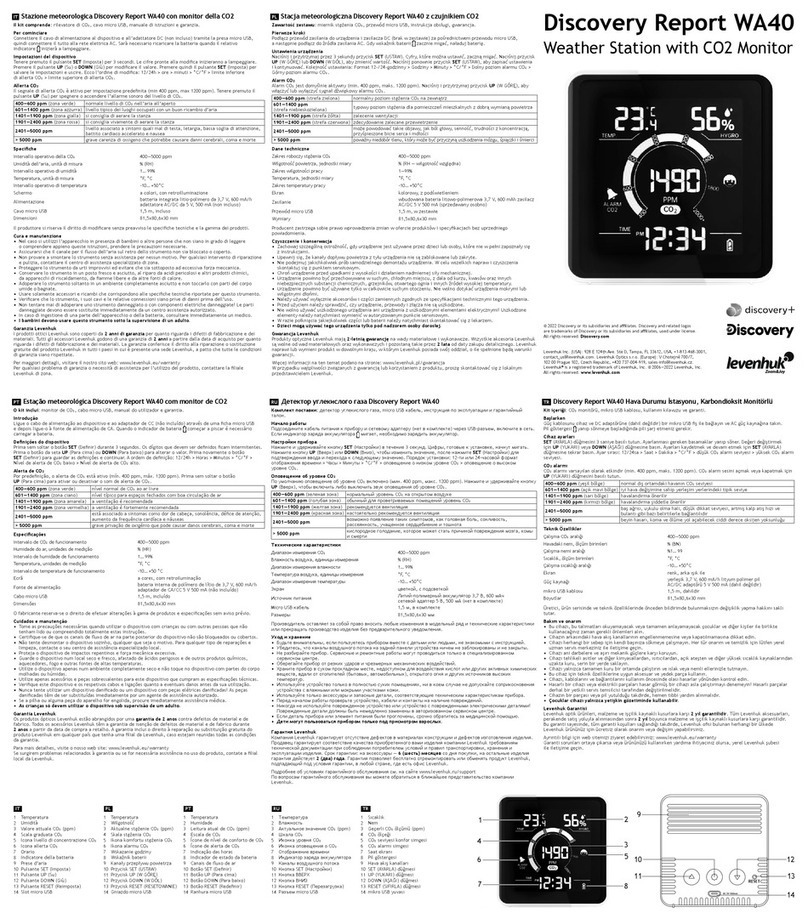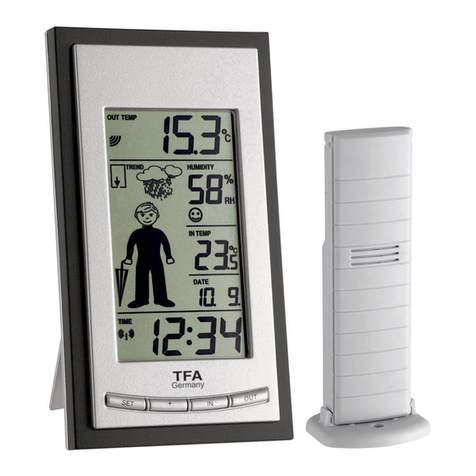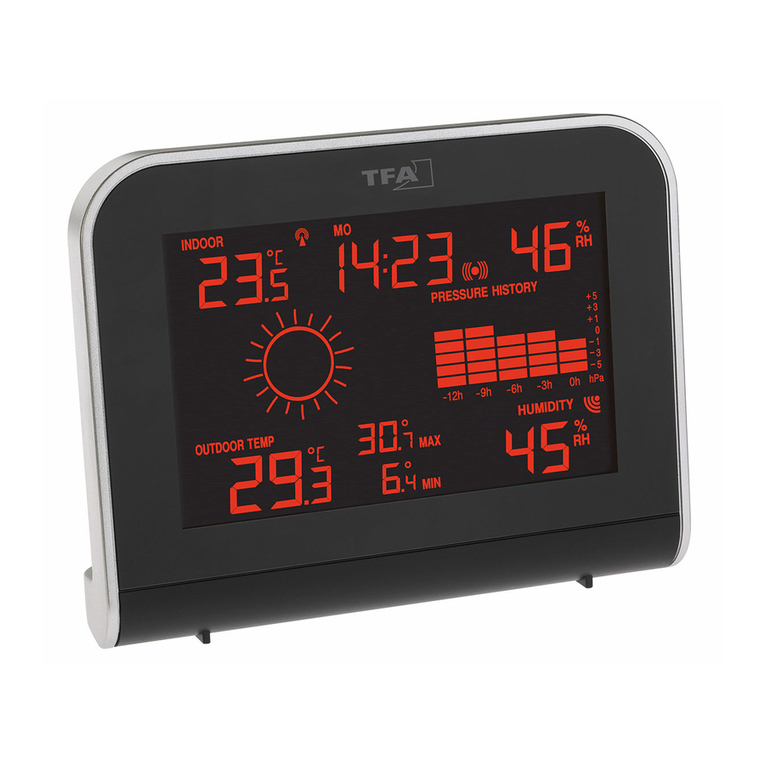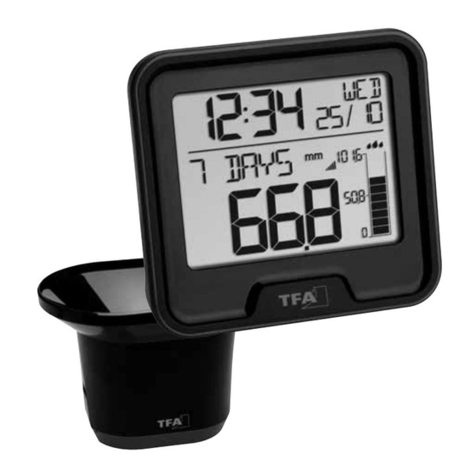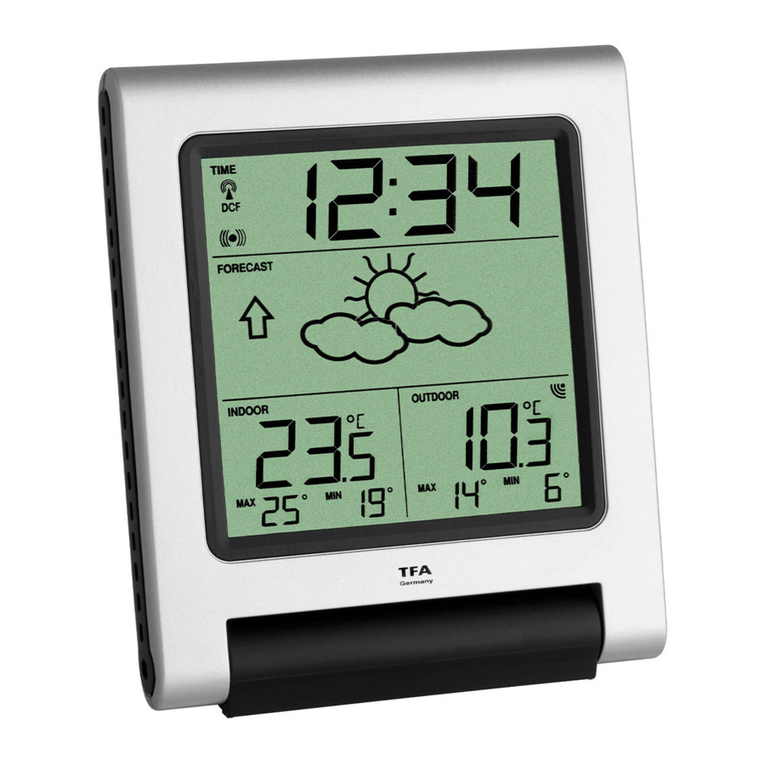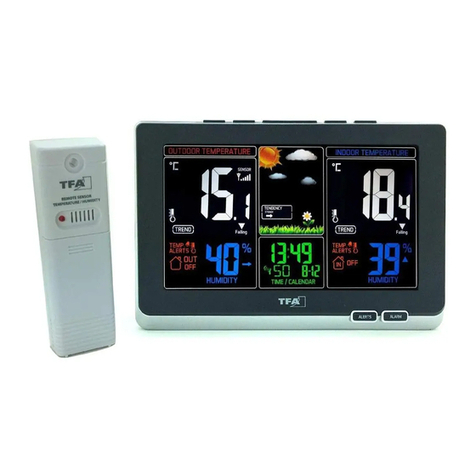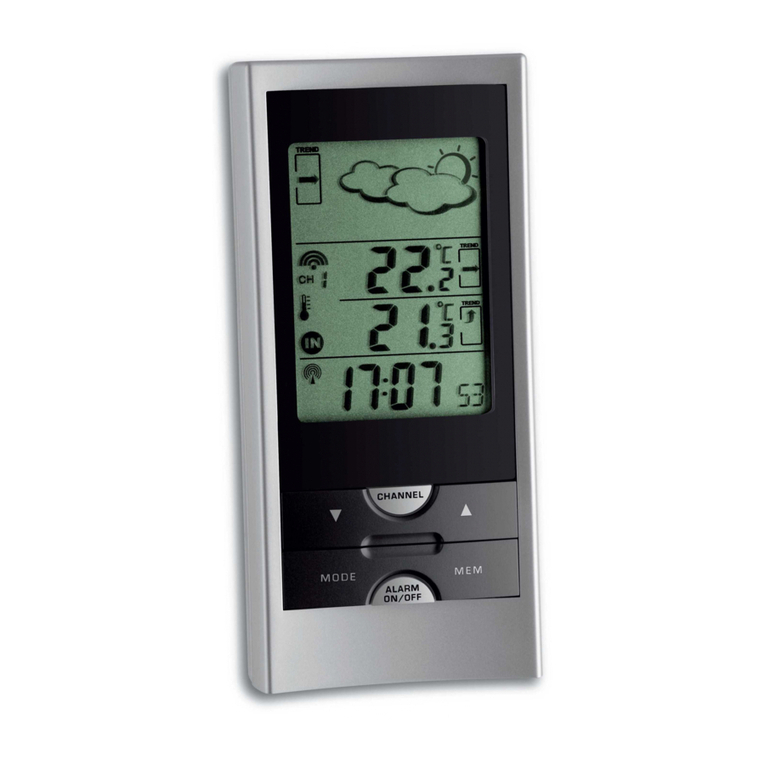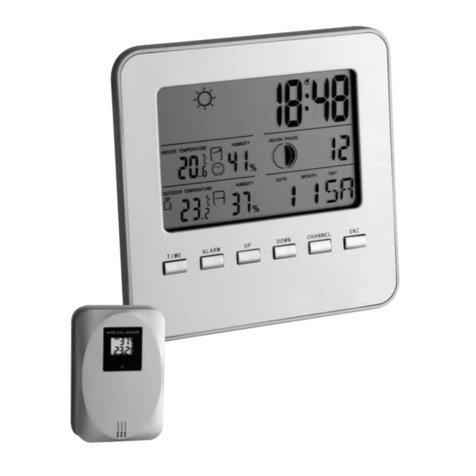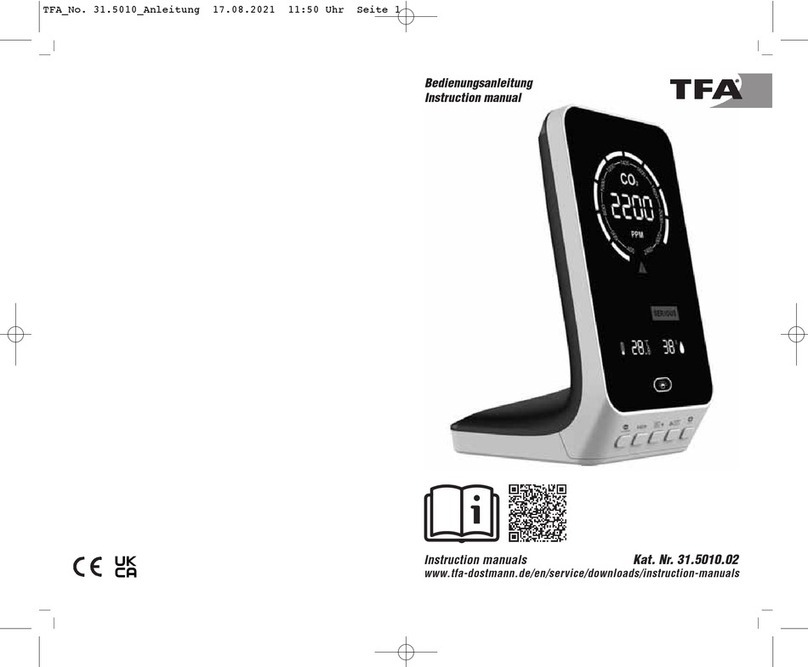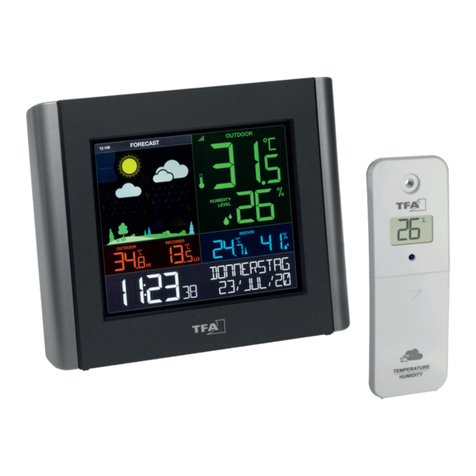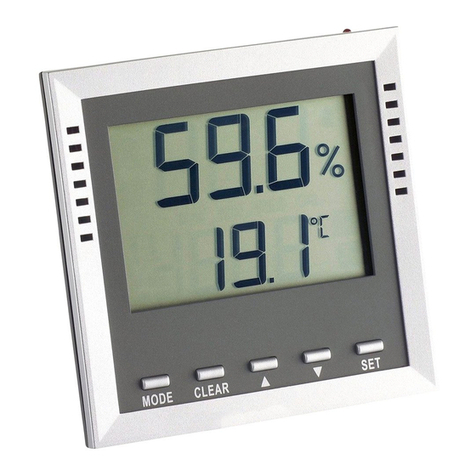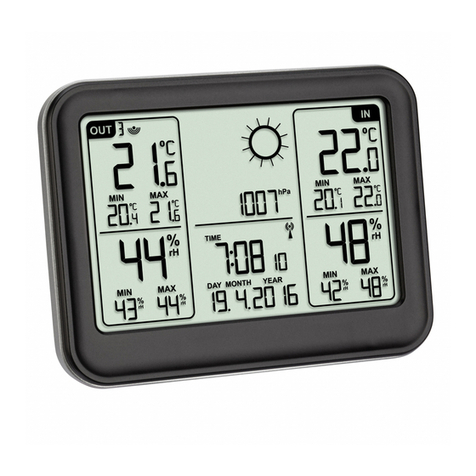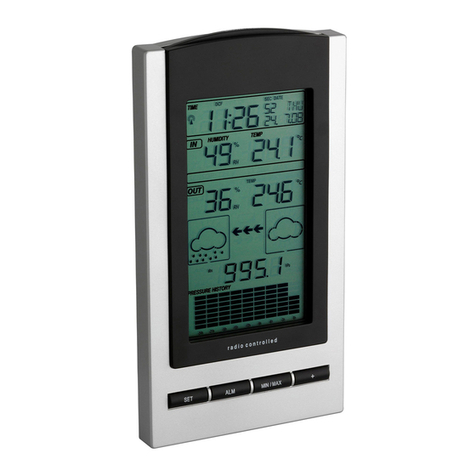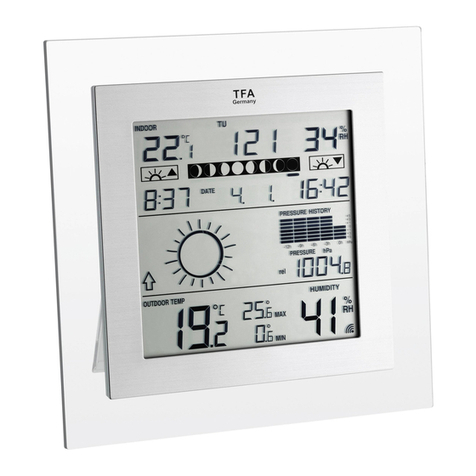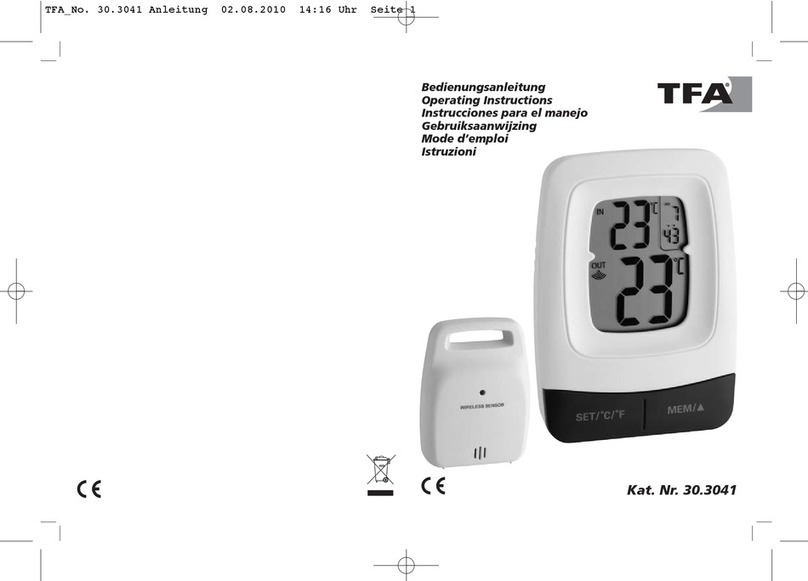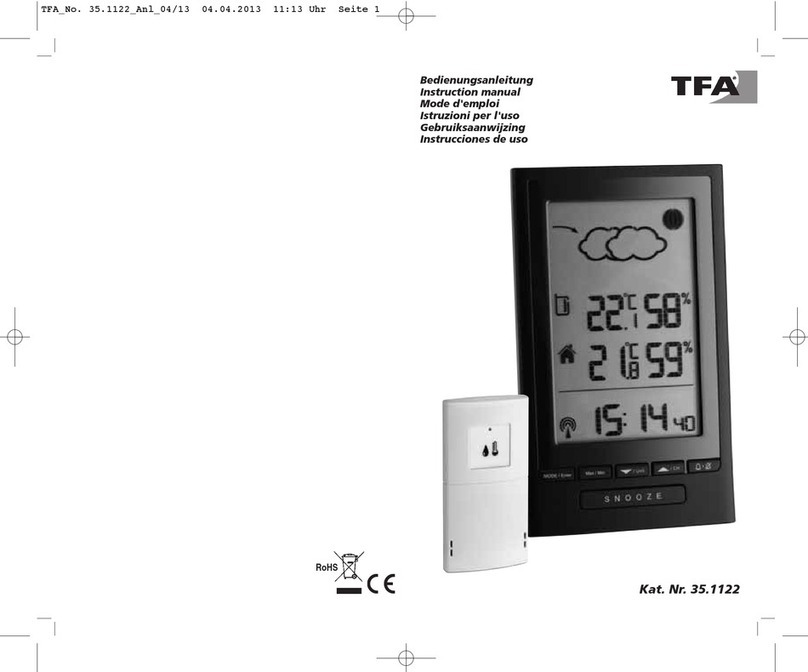1716
Wireless weather station
Wireless weather station
• Inside ferro-concrete rooms (basements, superstructures), the received signal is naturally weak-
ened. In extreme cases, please place the unit close to a window to improve the reception.
• During nighttime, the atmospheric interference is usually less severe and reception is possible in
most cases. A single daily reception is adequate to keep the accuracy deviation under 1 second.
8. Operation
•Important: During the reception of the outdoor values and the radio-controlled time, a button
operation is not possible.
• Press and hold the UP or DOWN button in the respective setting mode for fast running.
• The device will automatically quit the setting mode if no button is pressed within 30 seconds.
8.1 Manual settings
• Press and hold the MODE button in normal mode. The year digit (2011 YR - default) will be flash-
ing. Press the UP or DOWN to adjust the year.
• Press the MODE button to make the settings in the following sequence: the month, the day, the
day-of-week language (GE - default), the time zone (00 - default), the 12 or 24 hours system (24
H - default), the hours and the minutes. Press the UP or DOWN button to adjust it.
• Confirm with the MODE button.
• The manually set time will be overwritten by the DCF time when the signal is received successful-
ly.
8.1.1 Setting of the 12 and 24 hours display
• In the 12 HR system AM or PM (after 12 o'clock) appears on the display.
• Press the UP or DOWN button in the setting mode to choose the 12 HR or 24 HR system.
8.1.2 Setting of the time zone
• In the setting mode you can make the time zone correction (-12/+12).
• The time zone correction is needed for countries where the DCF signal can be received but the
time zone is different from the DCF time (e.g. +1=one hour later).
• ZONE appears on the display.
• Press the UP or DOWN button.
• Confirm the setting with the MODE button.
8.1.3 Setting of the language of the day-of-the week
• In the setting mode you can make the setting of the day-of-the week language: German (GE), Ital-
ian (IT), French (FR), Dutch (NE), Spanish (ES), Danish (DA) and English (EN).
8.2 Setting of the alarm time
• Press the ALARM button.
• AL and 7:00 (default) or the last adjusted alarm time appear on the display.
• Press and hold the ALARM button.
• The alarm symbol appears on the display and the hour digit will be flashing.
• Press the UP or DOWN button to adjust the hours.
• Press the ALARM button again and you can adjust the minutes with the UP or DOWN button.
• Confirm the setting with the ALARM button. The alarm is activated.
• Press the ALARM button again.
• The display shows the current time.
• When the adjusted alarm time is reached, the alarm will ring.
• The alarm symbol will be flashing.
• Press any button and the alarm will stop.
• If the alarm is not stopped manually, the increasing alarm will automatically turn off after certain
minutes and will be reactivated at the same time.
• When the alarm rings, press the SNOOZE-LIGHT button and the snooze function will be activated.
• Press the °C/°F button in the battery compartment of the outdoor transmitter, to change between
°C (Celsius) or °F (Fahrenheit) as temperature unit.
• Close the battery compartment again.
• Open the battery compartment of the base station and insert two new batteries 1.5 V AA, polarity
as illustrated.
• The device will alert you with a beep.
• All LCD segments will be displayed for about a few seconds.
• Close the battery compartment again.
6.2 Reception of the outdoor values
• After the batteries are inserted, the outdoor values will be transmitted to the base station. The
symbol will be flashing on the display near to the outdoor values. If the reception of the out-
door values fails, “- -” appears on the display. Check the batteries and try it again. Check if there
is any source of interference.
• As soon as the base station received the radio-controlled time, you can start the initialization
manually. Press and hold the CHANNEL button for three seconds. A short beep will be heard and
the base station will scan the outdoor values.
6.3 Reception of the DCF frequency signal
• The clock will now scan the DCF frequency signal and the DCF symbol will be flashing on the
display. When the time code is received successfully after 5-7 minutes, the radio-controlled time,
the date, the moon phase and the DCF symbol are displayed steadily on the display.
• You can start the initialization manually.
• Press and hold the UP button for three seconds.
• The DCF symbol will be flashing.
• Interrupt the reception by pressing the UP button again. The DCF symbol disappears.
• The DCF reception always takes place hourly between 2:05 and 6:05 o'clock in the morning. If the
reception is not successful until 6:05 o'clock in the morning, the next receive operation is again
at 2:05 o'clock in the morning.
• There are three different reception symbols:
flashing - reception is active
stays - reception is very good
No symbol - no reception / time is set manually
• If the clock cannot detect the DCF-signal (for example due to disturbances, transmitting distance,
etc.), the time can be set manually. The DCF symbol disappears and the clock will then work as a
normal quartz clock. (see: Manual settings).
7. Note for radio-controlled time DCF
The time base for the radio-controlled time is a caesium atomic clock operated by the Physikalisch
Technische Bundesanstalt Braunschweig. It has a time deviation of less than one second in one mil-
lion years. The time is coded and transmitted from Mainflingen near Frankfurt via frequency signal
DCF-77 (77.5 kHz) and has a transmitting range of approximately 1,500 km. Your radio-controlled
clock receives this signal and converts it to show the precise time. Changeover from summer time
or winter time is automatic. In Daylight Saving Time “DST” is shown on the LCD. The quality of the
reception depends mainly on the geographic location. Normally there should be no reception prob-
lems within a 1,500 km radius around Frankfurt.
Please take note of the following:
• The recommended distance to any interfering sources like computer monitors or TV sets is at
least 1.5 - 2 meters.
TFA_No. 35.1134_Anl_05_23 04.05.2023 17:30 Uhr Seite 9

